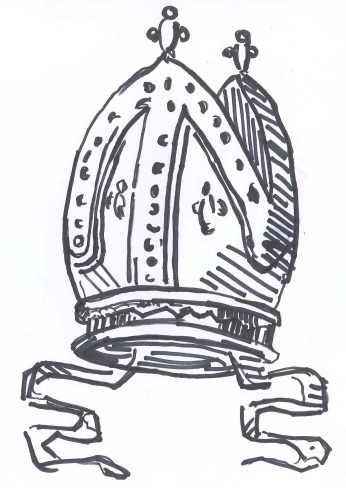First, my last on pontiff was recently Freshly Pressed by WordPress. Be sure to check it out if you missed it.
Now, speaking of the Pope, if you’re in D.C., New York, or Philadelphia this week, you may want to snag some papal swag. Perhaps an “I (mitre) the pope” t-shirt? Seeking a humbler pontificate, Pope Francis might prefer his zucchetto over his mitre (or miter), but, if he truly wants to build bridges, he should put on that special high, arched, and cleft ceremonial headdress. For the etymology of mitre bridges – or should I say, weaves together – the microscopic, the macroscopic, and just about everything in between.

Papal hats and baseball caps
According to the Oxford English Dictionary (OED), English first dons mitre in Wycliffe’s Bible during the late 1300s. In one passage, mitre refers to the “ceremonial turban of a high priest,” from which we eventually inherit today’s term for this episcopal headgear.
But historically, mitre wore many hats. Even in other passages of Wycliffe’s Bible we see other meanings the word had in its French, Latin, and, ultimately, Greek sources. As Liddell and Scott observe, the Ancient Greek μίτρα (mitra) was a “headband worn by Greek women to tie up their hair.” It was also a “Persian headdress or turban.” Principally, though, a mitra was a “belt or girdle worn around the waist beneath the cuirass.”
The OED also historically observes the mitre as “an Asian headdress,” curiously adding, “the wearing of which by men was regarded by the Greeks and Romans as a mark of effeminacy.” Speaking of turbans and curious associations, childhood friends of Yogi Berra, whom we lost this week, once “watched a feature [film] that had a Hindu fakir, a snake charmer who sat with his legs crossed and wore a turban on his head,” explains the Society for American Baseball Research. “When the yogi got up, he waddled and one of the boys joked that he walked like Lawdie. From then on Berra was known as Yogi.” (Lawdie was his Italian parents’ pronunciation of his given name, Lawrence).
Driving cells, driving cars
Now, some suppose that Greek’s μίτρα is derived from another Greek word, μίτος (mitos), “a thread of the warp” in weaving. The American Heritage Dictionary of Indo-European Roots (AHD) sees a common thread for mitra and mitos in the Proto-Indo-European root *mei-, “to tie.”
German scientists spun the Greek mitos into mitosis and mitochondrion. By 1887, Walther Flemming likened to threads the chromosomes he observed during the process of what he called mitosis. In 1898, Carl Benda saw the chain-like engines of cells, which he dubbed mitochondria, as “thread granules.” The name of another German scientist – Rudolf Diesel – is remembered in the name of a different kind of engine, the manipulation of which scandalized Volkswagen this week.
Looking to the heavens
Fibers can be tied together. So can people, forming a “contract” or “friendship,” as the AHD glosses the Indo-Iranian descendant of *mei-, *mitram. This concept, sacred to ancient peoples (not to mention modern ones, too), was “divinized as a god,” the AHD goes on. Specifically, *mitram was represented in the Persian Mithras, the god of light, and the Vedic Mitra, also associated with the sun. Buddhists await the Maitreya, a future bodhisattva, successor to the Buddha and the Sanskrit root shared by Mitra.
Jordan Shipley observes that we see sacred bonds also formed in the Judaic tradition, viz. the covenants struck between Noah and Moses and God, respectively. The kingly title of rulers, Mithridates, is considered a theophoric form of Mithras.
The name of a current ruler, Vladimir Putin, who made headlines by asking to meet with Barack Obama next week, is from the Old Church Slavonic Vladimirŭ, meaning “ruling peace,” ironically enough, many might say. The Slavic *mirŭ is believed to mean “commune,” “joy,” or “peace,” according to the AHD, a sense preserved in Russian’s mir. For the connecting sense, think “bound together,” a lesson that would behoove our world leaders.
Out of this world, huh? That would be Mir, as in the former space station, named for this Russian word for “peace” and “world.”
Whew! Some of my connections may be a bit threadbare. But mitre, if etymology is any measure, turns out to be not only a Catholic word, but a truly catholic word as well.
